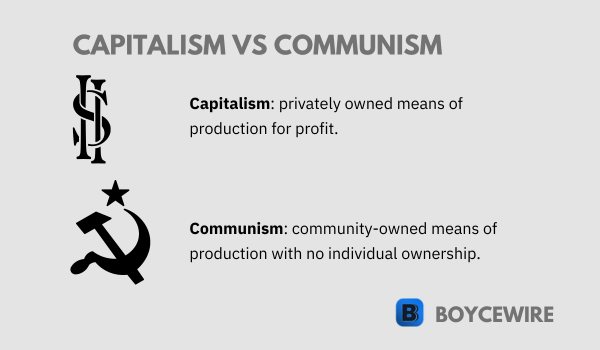Communism vs Capitalism

Introduction
Communism and capitalism represent two distinct economic and political systems that have shaped the modern world in various ways. Understanding the differences between these systems is essential for comprehending the diverse approaches to organizing societies and economies, as well as informing the ongoing debates on the merits and drawbacks of each.
This article aims to explore the distinctions between communism and capitalism by examining their historical backgrounds, fundamental principles, economic and political structures, role of the government, income distribution and social welfare policies, real-world examples, and criticisms and challenges. By delving into these aspects, we hope to provide a comprehensive understanding of the ideologies and practical implications of communism and capitalism, as well as the potential for hybrid systems that incorporate elements of both.
Key Points
- Capitalism favors a limited role for government in the economy, while communism involves a larger role for government in managing and directing economic activity.
- Under capitalism, goods and services are distributed based on market demand and the ability to pay, while under communism, they are distributed based on need.
- Capitalism involves private ownership and control of the means of production, while communism involves communal ownership and control.
Summary of Comparisons
| Comparison | Capitalism | Communism |
|---|---|---|
| Ownership and control of means of production | Privately owned and controlled | Communally owned and controlled |
| Distribution of goods and services | Based on market demand and ability to pay | Based on need |
| Role of government in economy | Limited role | Large role |
| Efficiency | More efficient in terms of production and innovation | More efficient in terms of resource allocation and meeting needs |
| Success | Success measured by wealth creation and innovation | Success measured by equality and social justice |
| Coexistence with other systems | Can coexist with mixed economies | Difficult to integrate with other systems |
1. Historical Background
Development of communist theories
- Karl Marx and Friedrich Engels: The roots of communism can be traced back to the works of Karl Marx and Friedrich Engels, who co-authored “The Communist Manifesto” in 1848. Their ideas centered on the struggle between social classes and the ultimate goal of establishing a classless society where the means of production are owned collectively.
- Vladimir Lenin: Lenin, a key figure in the development of communism, adapted and expanded upon the theories of Marx and Engels to guide the Bolshevik Revolution in Russia in 1917. Lenin’s contributions to communist theory, such as the concept of the vanguard party, were instrumental in the establishment of the world’s first communist state, the Soviet Union.
Evolution of capitalist theories
- Adam Smith: The foundations of capitalism are largely attributed to Adam Smith, a Scottish economist who published “The Wealth of Nations” in 1776. Smith’s theories emphasized the importance of individual self-interest, the division of labor, and the concept of the “invisible hand” guiding market forces in a competitive environment.
- David Ricardo: Ricardo, a British economist, contributed to the development of capitalism with his theory of comparative advantage, which highlighted the benefits of international trade and specialization. His ideas, published in “Principles of Political Economy and Taxation” (1817), continue to influence modern economic thought.
- John Maynard Keynes: Keynes, another influential British economist, revolutionized capitalist theory with his ideas on government intervention during economic downturns. His seminal work, “The General Theory of Employment, Interest, and Money” (1936), argued that governments should use fiscal and monetary policies to stabilize economies and combat recessions, thus challenging the traditional laissez-faire approach to capitalism.
The historical development of communism and capitalism has been shaped by the ideas of these prominent thinkers, as well as the evolving socio-political contexts in which their theories were applied. Understanding this historical background is crucial for appreciating the divergent principles and practical implications of each system.
2.Fundamental Principles
Communism
- Collective ownership: Communism is built upon the principle of collective ownership of the means of production, such as land, factories, and natural resources. This collective ownership aims to prevent exploitation and promote a more equitable distribution of resources and wealth.
- Class struggle and classless society: Communism is rooted in the idea that society is divided into classes based on their relationship to the means of production. The ultimate goal is to establish a classless society in which all people contribute according to their abilities and receive according to their needs.
- Abolition of private property: In a communist society, private property is replaced by communal ownership, with the aim of eliminating the social and economic disparities that arise from private ownership and wealth accumulation.
Capitalism
- Private ownership: Capitalism is characterized by private ownership of the means of production, where individuals or corporations can own and control resources and enterprises. This system promotes individual initiative, entrepreneurship, and the pursuit of personal gain.
- Profit motive: In a capitalist economy, the primary driving force is the profit motive, which encourages competition and innovation as businesses and individuals strive to maximize their financial gains.
- Free market: Capitalism relies on the concept of a free market, where the forces of supply and demand determine the allocation of resources, the production of goods and services, and the distribution of wealth. This market-driven system encourages efficiency, innovation, and economic growth.
While both communism and capitalism share the goal of creating prosperous societies, they differ fundamentally in their core principles and priorities. Communism emphasizes collective ownership, wealth redistribution, and the pursuit of a classless society, whereas capitalism focuses on private ownership, the profit motive, and the operation of a free market system.
3. Economic Systems
Communist economy
- Central planning: In a communist economy, the state plays a central role in determining the allocation of resources, production, and distribution of goods and services through a centrally planned economic system. This planning aims to address the needs of society and promote economic stability.
- State control: The means of production are owned and controlled by the state, with the goal of eliminating private ownership and wealth accumulation. This control extends to various sectors, including agriculture, industry, and services.
- Planned economy: Communist economies operate as planned economies, in which the state sets production goals, allocates resources, and determines the distribution of goods and services. This system aims to prevent market failures, such as monopolies and unemployment, and ensure that resources are used efficiently to meet societal needs.
Capitalist economy
- Market-driven: Capitalist economies are market-driven, where the forces of supply and demand determine the allocation of resources, production of goods and services, and distribution of wealth. This allows for flexibility and adaptability in response to changes in consumer preferences and market conditions.
- Competition: Capitalism thrives on competition, which encourages businesses to innovate, improve efficiency, and offer better products and services to consumers. This competition can lead to economic growth, job creation, and a higher standard of living for society as a whole.
- Private enterprise: In a capitalist economy, private enterprises have the freedom to operate and make decisions based on market conditions and profit potential. This autonomy enables businesses to respond quickly to market changes, take risks, and pursue new opportunities.
The economic systems of communism and capitalism differ significantly in terms of the roles played by the state and the market, as well as the underlying principles that govern the allocation of resources, production, and distribution of goods and services. While communism relies on central planning and state control, capitalism emphasizes market forces and competition to drive economic activity.
4. Political Systems
Communist political structure
- One-party system: Communist countries typically have a one-party system, with the communist party holding a monopoly on political power. This structure aims to ensure the implementation of communist principles and maintain ideological purity within the government.
- State control: The communist party exerts significant control over the government and various aspects of society, including the media, education, and cultural institutions. This control is intended to prevent dissent and opposition to the communist ideology.
- Suppression of dissent: In many communist countries, political dissent and opposition are actively suppressed through various means, such as censorship, surveillance, and persecution. This suppression is justified as necessary to protect the revolution and maintain the unity and stability of the communist state.
Capitalist political structure
- Multi-party system: Capitalist countries generally have a multi-party political system, which allows for a diverse range of political views and ideologies to be represented within the government. This pluralism encourages democratic processes, such as free and fair elections, as well as checks and balances on political power.
- Varying degrees of state involvement: In capitalist societies, the state’s role in the economy and society can vary significantly, from minimal intervention in laissez-faire capitalism to more extensive regulation and oversight in mixed economies. This variation allows for the adaptation of capitalist principles to different political and social contexts.
- Protection of individual rights and freedoms: Capitalist political systems typically emphasize the protection of individual rights and freedoms, such as freedom of speech, assembly, and the press. This protection fosters open debate, innovation, and the free exchange of ideas, which are crucial for the functioning of a democratic society.
The political systems of communism and capitalism differ in several key aspects, including the structure of government, the role of the state in society, and the protection of individual rights and freedoms. While communism is characterized by a one-party system, state control, and the suppression of dissent, capitalism generally features a multi-party system, varying degrees of state involvement, and the protection of individual rights and freedoms.
5. Role of the Government
Government’s role in communism
- Economic planning: In a communist system, the government is responsible for creating and implementing centralized economic plans that determine the allocation of resources, production levels, and distribution of goods and services. This planning aims to ensure that the economy serves the needs of the society as a whole.
- Regulation and control: The communist government exercises extensive control over various aspects of society, including business, agriculture, education, and healthcare. This control is intended to prevent the exploitation of workers, protect the environment, and promote social equality.
- Social welfare: The government in a communist system plays a significant role in providing social welfare services, such as housing, healthcare, and education. These services are typically available to all citizens, regardless of their economic status, in order to promote social cohesion and reduce inequality.
Government’s role in capitalism
- Limited intervention: In a capitalist system, the government’s role is generally limited to protecting individual property rights, enforcing contracts, and maintaining law and order. This limited intervention allows the market to function efficiently and fosters economic growth and innovation.
- Regulation and oversight: The government in a capitalist system may also be involved in regulating and overseeing certain industries to prevent market failures, protect consumers, and preserve competition. This regulation can range from minimal intervention in laissez-faire capitalism to more extensive oversight in mixed economies.
- Social welfare and safety nets: In some capitalist countries, the government provides social welfare programs and safety nets to assist citizens who are unable to meet their basic needs due to unemployment, illness, or other factors. These programs vary widely in scope and generosity, depending on the political and social context of the country.
The role of the government in communism and capitalism is markedly different, reflecting the divergent priorities and principles of each system. While the communist government is heavily involved in economic planning, regulation, and social welfare, the capitalist government typically adopts a more limited role, focusing on protecting individual rights and providing a stable environment for market-driven economic activity.
6.Income Distribution and Social Welfare
Income distribution in communism
- Redistribution of wealth: Communism seeks to create a more equitable distribution of wealth by redistributing resources through progressive taxation, social welfare programs, and the communal ownership of the means of production. This approach aims to minimize income inequality and ensure that all members of society have access to basic necessities.
- Emphasis on social welfare: In a communist system, the government is responsible for providing social welfare services, such as healthcare, education, and housing. These services are typically available to all citizens, regardless of their economic status, in order to promote social cohesion and reduce inequality.
- Elimination of class distinctions: The ultimate goal of communism is to establish a classless society, in which all individuals contribute according to their abilities and receive according to their needs. This aspiration aims to eliminate the exploitation of workers and create a more egalitarian society.
Income distribution in capitalism
- Market-driven distribution: Capitalism relies on the market to determine the distribution of wealth, with individual incomes primarily based on factors such as education, skills, and job performance. This market-driven approach can lead to significant income disparities, as those with more valuable skills and resources are able to command higher wages.
- Meritocracy: Capitalism promotes the idea of meritocracy, in which individuals are rewarded for their hard work, innovation, and risk-taking. This system encourages personal initiative and entrepreneurship, which can drive economic growth and improve living standards for society as a whole.
- Social welfare and safety nets: Some capitalist countries provide social welfare programs and safety nets to assist citizens who are unable to meet their basic needs due to unemployment, illness, or other factors. These programs vary widely in scope and generosity, depending on the political and social context of the country, and can help to mitigate some of the income inequality inherent in market-driven systems.
Income distribution and social welfare policies in communism and capitalism reflect the contrasting values and priorities of each economic system. Communism emphasizes wealth redistribution, social welfare, and the pursuit of a classless society, while capitalism relies on market-driven income distribution, meritocracy, and the provision of social welfare programs and safety nets to address income inequality.
7. Real-World Examples
Communist countries
- Soviet Union (1922-1991): The Soviet Union was a prominent example of a communist state, governed by the Communist Party and adhering to the principles of Marxism-Leninism. The centrally planned economy aimed to achieve rapid industrialization and collectivization of agriculture, leading to significant economic growth in the early years. However, the system faced challenges such as inefficiency, bureaucracy, and stagnation, ultimately contributing to the Soviet Union’s dissolution in 1991.
- China: Since 1949, the People’s Republic of China has been governed by the Communist Party of China. Initially following a Soviet-style planned economy, China experienced significant economic and social upheaval during the Great Leap Forward and the Cultural Revolution. In the late 1970s, under the leadership of Deng Xiaoping, China began implementing economic reforms that introduced market elements into its socialist system, resulting in rapid economic growth and lifting millions out of poverty.
Capitalist countries
- United States: As a leading example of a capitalist country, the United States has a market-driven economy with a strong emphasis on individualism, entrepreneurship, and private enterprise. The country’s economic success has been fueled by innovation, a well-educated workforce, and abundant natural resources. However, it also faces challenges such as income inequality, poverty, and a lack of access to affordable healthcare for many citizens.
- Germany: Germany’s social market economy combines capitalist principles with strong social welfare policies and labor protections. This mixed economy has resulted in a high standard of living, low unemployment, and a strong social safety net for its citizens. Germany’s emphasis on vocational training, worker representation, and cooperation between businesses and labor unions has contributed to the success of its manufacturing sector and overall economy.
These real-world examples of communist and capitalist countries illustrate the varied approaches to economic and social organization that each system entails. While the Soviet Union and China pursued centrally planned economies and state control, the United States and Germany have embraced market-driven systems with differing degrees of government intervention and social welfare provisions.
8. Criticisms and Challenges
Criticisms of communism
- Lack of incentives: Critics argue that communism’s emphasis on collectivism and equal distribution of wealth can lead to a lack of incentives for individuals to work hard, innovate, and take risks. This lack of motivation can stifle economic growth and lead to a lower overall standard of living.
- Economic inefficiency: Centralized planning and state control can result in inefficiencies, as the government may lack the information and flexibility necessary to respond to changing market conditions and consumer needs. This can lead to shortages, surpluses, and a general misallocation of resources.
- Suppression of personal freedoms: In many communist countries, the government’s control over various aspects of society has led to the suppression of personal freedoms, such as freedom of speech, assembly, and religion. This can create a repressive environment and stifle creativity and innovation.
Criticisms of capitalism
- Income inequality: Capitalism’s market-driven distribution of wealth can result in significant income disparities, with a small percentage of the population accumulating a disproportionate share of resources. This inequality can lead to social unrest, reduced economic mobility, and limited access to essential services for those in lower-income brackets.
- Exploitation of workers: Critics argue that capitalism’s emphasis on profit can lead to the exploitation of workers, with companies seeking to minimize labor costs and maximize shareholder returns. This can result in low wages, poor working conditions, and job insecurity for many workers.
- Environmental degradation: The pursuit of profit in a capitalist system can contribute to environmental degradation, as businesses may prioritize short-term gains over long-term sustainability. This can result in pollution, deforestation, and depletion of natural resources, with potentially devastating consequences for future generations.
Both communism and capitalism face criticisms and challenges related to their underlying principles and real-world implementations. Communism has been criticized for its potential to suppress personal freedoms and create economic inefficiencies, while capitalism faces critiques related to income inequality, worker exploitation, and environmental degradation. These criticisms highlight the ongoing debate surrounding the merits and drawbacks of each economic system.
Conclusion
Communism and capitalism represent two distinct approaches to organizing economic and social systems, each with its own set of principles, priorities, and challenges. While communism seeks to create a classless society with wealth redistribution and strong government intervention, capitalism emphasizes individualism, market-driven wealth distribution, and limited government involvement.
Real-world examples, such as the Soviet Union and China for communism and the United States and Germany for capitalism, showcase the varied ways in which these systems have been implemented and the outcomes they have produced. Both systems face criticisms and challenges, with communism being critiqued for its potential to suppress personal freedoms and create economic inefficiencies, and capitalism for its contribution to income inequality, worker exploitation, and environmental degradation.
The ongoing debate between communism and capitalism highlights the importance of carefully considering the values, goals, and potential consequences of different economic systems. Ultimately, the choice between these systems depends on the priorities and preferences of individual societies and the specific historical, political, and cultural contexts in which they operate.
FAQs
Capitalism is an economic system where the means of production and distribution are privately owned and operated for profit.
Communism is a political and economic system where the means of production and distribution are owned and controlled by the community as a whole, with no individual ownership.
Capitalism and communism differ in terms of ownership and control of the means of production, distribution of goods and services, and the role of the government in the economy. In capitalism, private individuals and businesses own and control the means of production and goods and services are distributed through the market. In communism, the means of production are owned and controlled by the community as a whole, and goods and services are distributed based on need, rather than on the ability to pay. The government plays a much larger role in the economy under communism, whereas capitalism favors a more laissez-faire approach.
Efficiency can be difficult to measure and depends on the specific goals and values of a society. Capitalism tends to be more efficient in terms of production and innovation, as competition among businesses drives efficiency and innovation. However, communism can be more efficient in terms of resource allocation and meeting the needs of all members of society, as the focus is on meeting the needs of the community as a whole, rather than maximizing profit for individuals.
This is a matter of debate, as it depends on how one defines “success.” Capitalism has been successful in creating wealth and promoting innovation, but has also been associated with income inequality and environmental degradation. Communism has been successful in promoting equality and social justice, but has been associated with lack of individual freedoms and economic stagnation in some cases.
About Paul
Paul Boyce is an economics editor with over 10 years experience in the industry. Currently working as a consultant within the financial services sector, Paul is the CEO and chief editor of BoyceWire. He has written publications for FEE, the Mises Institute, and many others.

Further Reading
 Cyclical Unemployment: (What it is, 3 Causes & Example) - Cyclical unemployment is where unemployment trends in line with the business cycle.
Cyclical Unemployment: (What it is, 3 Causes & Example) - Cyclical unemployment is where unemployment trends in line with the business cycle.  Common Stock: Definition, Characteristics & Examples - A type of financial asset that represents ownership of the company.
Common Stock: Definition, Characteristics & Examples - A type of financial asset that represents ownership of the company.  SWOT Analysis: Definition, Template & Example - SWOT Analysis is a strategic management tool to help individuals and businesses identify their Strengths, Weaknesses, Opportunities, and Threats.
SWOT Analysis: Definition, Template & Example - SWOT Analysis is a strategic management tool to help individuals and businesses identify their Strengths, Weaknesses, Opportunities, and Threats. 